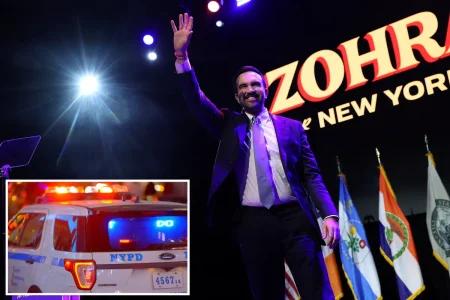“Burberry Bandit” Returns to NYC Streets Despite New Bank Robbery Allegations
Cornell Neilly, a 35-year-old repeat offender dubbed the “Burberry Bandit,” has once again found himself at the center of controversy after being released from custody following his arrest for multiple bank robberies across New York City. Neilly earned his distinctive nickname back in 2012 when surveillance cameras captured him wearing clothing patterns resembling the luxury Burberry brand during previous heists. His recent freedom has sparked renewed debate about New York’s criminal justice system and the decisions made by judges regarding repeat offenders, particularly those with extensive criminal histories who continue to engage in similar crimes after release.
According to police reports, Neilly’s most recent alleged crime spree began on August 16 and continued through mid-September, involving five separate bank robberies throughout Manhattan. His method remained consistent: entering Chase Bank branches and passing notes to tellers demanding specific amounts of money, usually around $3,500. His first target was a Midtown Manhattan Chase location where he allegedly demanded $3,500 but left with $1,000. Nine days later, on August 25, he allegedly struck again at another Chase branch on Park Avenue, making off with $716 after requesting the same amount. The pattern continued with three more attempted robberies in September, including one where a teller triggered a silent alarm, causing Neilly to flee empty-handed. During one incident, he allegedly passed a note reading, “This is a robbery. I want all large bills. Now. This is real.”
What makes this case particularly notable is Neilly’s extensive criminal history. Law enforcement confirmed to Fox News Digital that he has amassed over 34 prior arrests, many for similar bank robberies. Despite this lengthy rap sheet and the new charges, Brooklyn Supreme Court Judge Jeffrey Gershuny made the decision to release Neilly on supervised release, rejecting the prosecution’s request for substantial bail ($50,000 cash or $150,000 bond). This decision has drawn sharp criticism from law enforcement personnel, with one anonymous NYPD officer calling it “negligent” and showing “a real lack of care for public safety.” The officer expressed concern that continued releases could lead to escalation: “At what point does he keep getting out and gets desperate and brings a gun to a robbery instead of a note and kills somebody?”
Adding another layer to this controversial judicial decision is Judge Gershuny’s own recent professional troubles. According to reports, just one month before Neilly’s case came before him, the judge had been demoted to handling misdemeanor cases in criminal court following an unusual incident on the bench. During an August weapons case hearing, Gershuny reportedly pulled out his own firearm while asking a police officer to demonstrate how a suspect had concealed a weapon. This incident resulted in his reassignment to night court cases in Manhattan Criminal Court, raising questions about his judgment in sensitive criminal matters. When approached for comment, the state Office of Court Administration declined to address the specific bail determination but emphasized that “the vast majority of bail decisions turn on the court’s discretionary weighing of a broad range of factors.”
The case highlights the ongoing tensions in New York City’s criminal justice system, particularly regarding the treatment of repeat offenders. Critics argue that allowing individuals with extensive criminal histories to return to the streets without substantial bail requirements endangers public safety and fails to address recidivism. Supporters of bail reform, however, contend that the bail system has historically discriminated against lower-income defendants and that pretrial detention should not be determined primarily by financial means. Neilly’s case exemplifies this debate, as his pattern of alleged criminal behavior continues despite numerous previous arrests and periods of incarceration.
The “Burberry Bandit” now faces five counts of felony robbery and is scheduled to return to court on October 1. His release conditions require supervision, though specific details about what this entails haven’t been made public. For many New Yorkers, particularly those working in law enforcement, cases like Neilly’s represent frustration with a system they see as failing to protect communities from repeat offenders. The outcome of his case may become another data point in the ongoing evaluation of New York’s approach to bail and pretrial detention, especially for defendants with lengthy criminal histories who continue to face similar charges after previous releases.
As the debate continues, both law enforcement and criminal justice reform advocates watch closely, each pointing to cases like Neilly’s as evidence supporting their positions on how the system should function. Meanwhile, bank employees across Manhattan remain vigilant, aware that despite his numerous arrests, the man known as the “Burberry Bandit” walks free as he awaits his next court appearance. Whether this supervised release represents a second chance for rehabilitation or a missed opportunity to prevent further crimes remains to be seen, but it certainly underscores the complex challenges facing New York’s criminal justice system in balancing public safety concerns with the rights of the accused.









